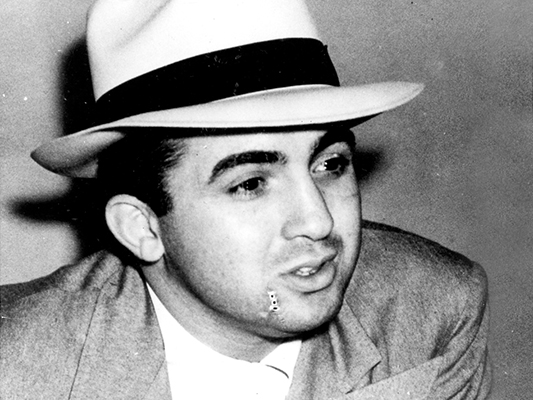Mickey Cohen

Born: September 4, 1913, Brooklyn, New York
Died: July 29, 1976, Los Angeles
Nickname: Irish Mickey, Gangster Mickey
Associates: Benjamin “Bugsy” Siegel, Meyer Lansky, the Outfit, Jack Dragna, Candy Barr, Johnny Stompanato
Like so many American mobsters, Meyer Harris Cohen started out hustling newspapers on the streets of New York City, but his Orthodox Jewish family rewrote the traditional script by moving from Brooklyn to Los Angeles when Mickey was nine years old.
He quickly got into trouble and was sent to reform school, where he picked up amateur boxing skills. When Cohen was 15, he moved to Cleveland in an effort to become a professional boxer, eventually competing in some minor fights. At the time, many fights were “fixed” — the outcome was known in advance — although that did not deter gamblers from wagering. On April 8, 1930, Cohen fought his first professional bout in Cleveland, winning against Patsy Farr in the only fight of Farr’s short career.
Cohen lost his next five in a row. According to Boxrec.com, Cohen ended his boxing career with a lifetime record of 7 wins, 11 losses and 1 draw. Most of the fights were in Cleveland, but there were two in Chicago and two in California, including one in his hometown of Los Angeles. For at least one bout in Cleveland, he fought under the moniker “Gangster Mickey Cohen.”
In Cleveland, Cohen met associates of Moe Dalitz, a Midwestern bootlegger who would go on to become one of Las Vegas’ leading casino operators. It also was in Cleveland that Cohen was arrested for armed robbery, although he beat the rap.
Trying to avoid the scrutiny of police, who now had Cohen on their radar, the young gangster moved to Chicago, where he went to work for the Outfit, the criminal organization founded by Al Capone. According to published biographies, Cohen ran a gambling operation there in the waning days of Prohibition. Cohen afterwards claimed to have met Capone, but the timeline is difficult to reconcile: Capone likely was already in prison for income tax evasion by the time Cohen was operating in Chicago.
In 1937, with the backing of the Outfit, Cohen relocated to Los Angeles with a mission to organize the rackets in swiftly growing Southern California. Cohen eventually tangled with other mobsters, especially Jack Dragna, his rival for rackets and the lucrative “race wire.” It was a long-running, vicious and bloody gang war.
Cohen’s legitimate businesses and criminal rackets were all over the map during his long career in L.A. Cohen operated jewelry stores and ice cream trucks, dinner clubs and loan-sharking operations. He shook down business and labor groups, and he allegedly was at the center of a pornography and blackmail operation that penetrated deep into the heart of the Hollywood community and local government leadership. He was arrested and fined a token amount for beating up a rival in 1942, but, with a lawyer paid for by national Syndicate boss Frank Costello, the killing of a professional rival, Max Shaman, in May 1945, was ruled self-defense by the L.A. County district attorney.
He was credited by Meyer Lansky with helping to engineer the original partnership between the Teamsters Union and the Mob, had the support of Charles “Lucky” Luciano to be the boss of the Los Angeles rackets, and called crooner Frank Sinatra a friend.
Along the way, Cohen publicly and financially supported the congressional campaign of a young Richard Nixon. He met and befriended a young evangelical named Billy Graham, and made a fan of William Randolph Hearst, the publishing magnate.
In June 1951, Cohen was convicted of tax evasion and sentenced to four years in prison. A decade later, Cohen was again convicted of tax evasion, and did 11 years in federal prisons (where he survived an assassination attempt, one of a reported 11 in his career).
In his personal life, Cohen was married to wholesome-looking actress LaVonne Cohen from 1940 to 1958; was linked to actress Liz Renay, who spent three years in jail for refusing to inform on him; and dated the burlesque queens Tempest Storm, Candy Barr and Beverly Hills.
Cohen hired John “Johnny Stomp” Stompanato as a bodyguard. Stompanato was killed by his girlfriend, Lana Turner’s daughter, in a domestic violence situation in 1958. Cohen paid for Stompanato’s funeral.
Already famous – or infamous — after his testimony before the Kefauver Committee and for his high-profile lifestyle in Los Angeles, Cohen did a live television interview in 1957 with Mike Wallace, later of 60 Minutes fame. During the interview, Cohen admitted to killing at least one man in self-defense and harshly attacked Los Angeles Police Chief William Parker.
Cohen continued to make news and operate various businesses throughout his life. He was diagnosed with stomach cancer after leaving his second stint in federal prison in 1972, and died in his sleep in 1976.




